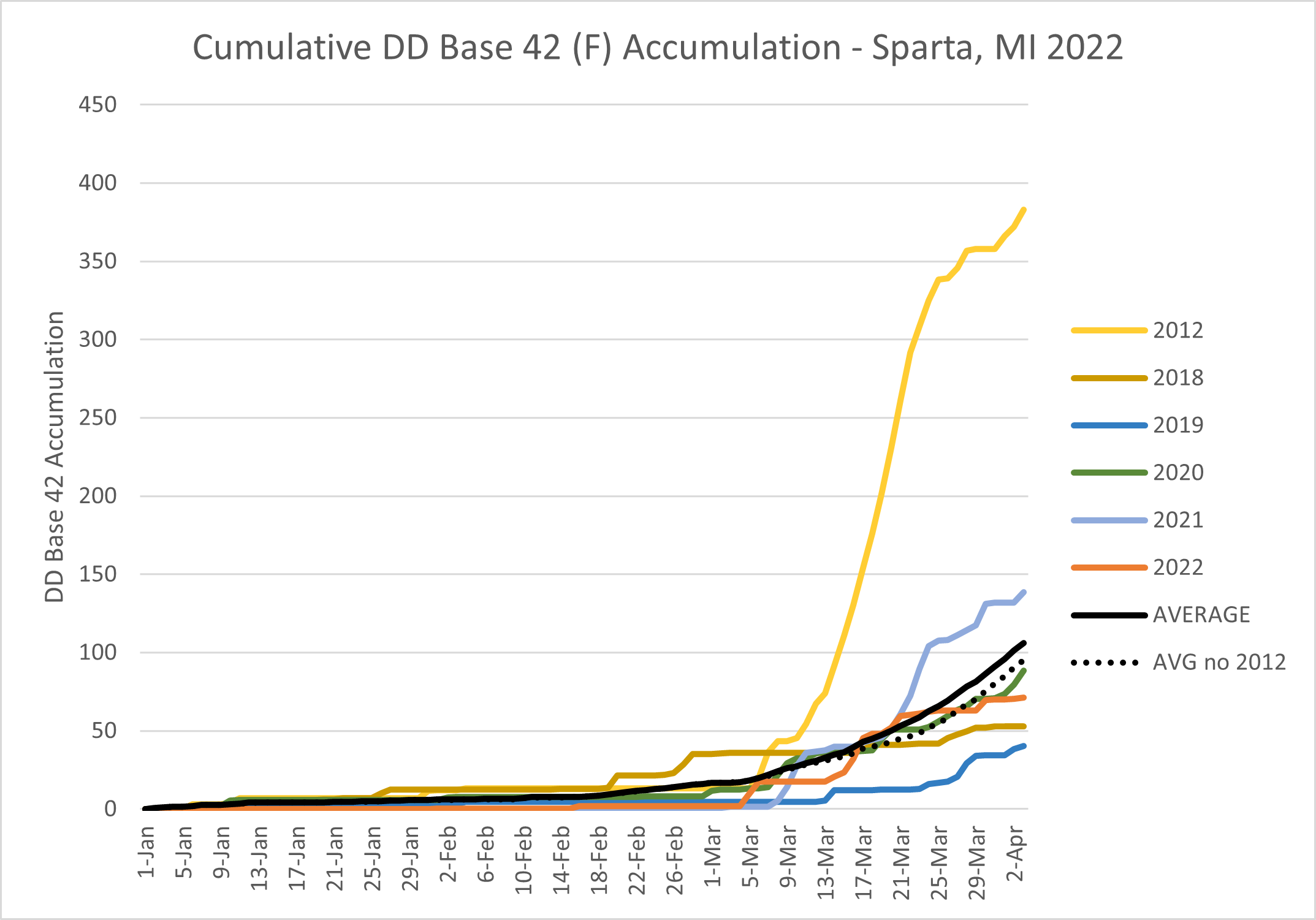Grand Rapids area tree fruit update – March 29, 2022
Cooler than normal conditions are leading to a delayed spring.

Weather and phenology update
In the Grand Rapids, Michigan, area, spring is off to a slow start as a result of cool weather conditions. Bud swell is evident in some varieties and silver tip has been observed on a few buds of very early apple varieties such as Idared and Gingergold. Two periods of warm weather were observed earlier this month, with highs reaching into the 60s (degrees Fahrenheit) on March 5 and again from March 17-19. This was followed by a cold temperature trend and snow over the past week. In addition to cool air temperatures, soil temperatures remain very cold, overall keeping things quite dormant.
How does 2022 compare to normal? As of March 28, the Michigan State University Sparta Enviroweather station has accumulated 63.1 growing degree days base 42 F (GDD42). This is below average, which for March 28 in Sparta is 78.2 GDD42. Last season (2021) at this time, heat accumulation was slightly above average with 114.3 GDD42 and green tip reported in Gala on March 29. The projected heat accumulation through Sunday, April 3, for this season in Sparta is 71.1 GDD42. This continues to be below average, which is 106.2 GDD42. As a result, conditions are expected to remain behind normal.
When will we reach bud break? Average GDD42 for bud break (first green) is 127 for McIntosh. However, other varieties will be ahead or behind this, and even McIntosh varies considerably from year to year. The 8–14-day forecast indicates conditions are expected to continue to be close to normal over the next two weeks, with slightly above average rainfall. We can expect cold temperatures below freezing overnight tonight, then a very warm trend Wednesday with temperatures near 60 F. This will be accompanied by considerable precipitation, beginning as ice and transitioning to rain, with an accumulation of approximately 1 inch. This will be followed by a return to cold conditions for the remainder of the week.
The long term (one month) forecast indicates conditions are likely to be slightly warmer and wetter than average, which has the potential to accelerate bud development. At this point, it looks like we can expect a slightly later than average spring.

|
GDD42 accumulation and forecast for Sparta |
||||
|---|---|---|---|---|
|
Day |
Date |
2021 |
2022 |
Average |
|
Su |
4/3/2022 |
138.6 |
71.1 |
106.2 |
|
Sa |
4/2/2022 |
132.1 |
70.5 |
101.2 |
|
F |
4/1/2022 |
131.8 |
70.0 |
95.8 |
|
Th |
3/31/2022 |
131.8 |
70.0 |
91.1 |
|
W |
3/30/2022 |
131.0 |
69.8 |
86.4 |
|
Tu |
3/29/2022 |
117.6 |
63.2 |
81.3 |
|
M |
3/28/2022 |
114.3 |
63.1 |
78.2 |
|
Su |
3/27/2022 |
111.3 |
63.1 |
73.9 |
|
Sa |
3/26/2022 |
108.1 |
63.1 |
69.3 |
|
F |
3/25/2022 |
107.8 |
63.1 |
65.7 |
|
Th |
3/24/2022 |
104.2 |
62.4 |
62.6 |
|
W |
3/23/2022 |
89.7 |
61.1 |
58.7 |
|
Tu |
3/22/2022 |
72.4 |
60.2 |
56.0 |
|
M |
3/21/2022 |
60.7 |
59.4 |
53.1 |
For these updates, we used averages for 1997-2021 from the Michigan Automated Weather Network (MAWN) to represent normal conditions. Weather data was gathered from MSU Enviroweather.
More information and reports on normal weather conditions and departures from normal can be found on the NOAA Climate Prediction Center website, NOAA U.S. Climate Normals website, NOAA Climate Normals Quick Access Page (which may be searched by region) and Midwest Regional Climate Center website.
Pest updates
It is too early and too cold for insect or disease pest activity in the Grand Rapids area orchards. Apple scab pressure in 2021 was low overall and inoculum for 2022 should be lower as well. Also, the winter was mostly a steady cold and spore maturity might be slower to get started. Apple scab management will still be required, but hopefully this equates to a slow start to primary scab for 2022. Early season copper sprays for fire blight will also help for apple scab.
There is very little happening this last week of March in the insect arena, and cooler weather on tap for the 8–14-day forecast will delay early insect activity such as San Jose scale, obliquebanded leafroller, mites and aphids. This is a good time go over 2021 scouting reports to identify problem areas to address in 2022.
Very little dormant oil is used in commercial apples these days, but it is still your best first management tactic for mites, scale and aphids. There were some apple blocks with higher levels of mites in 2020 and 2021 than we have seen for some years, and this will need to be monitored carefully early in the season. Overwintering mite eggs can be scouted for now—look for them in the cracks and crevices of bark on the trunks of trees.



 Print
Print Email
Email
